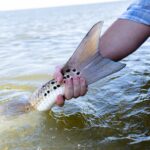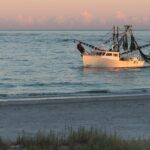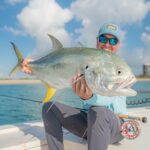New Alabama Redfish Regs: Conservation Momentum Grows
Photo Credit: Graham Tayloe Big Win for Redfish in Alabama Huge news from the Marine
Feature Photo: A Healthy Striped Bass landed by Capt. Brian Kelly & his anglers.
It appears that the old motto “Virginia is for lovers” didn’t apply to striped bass this year. Earlier today, we reported that Maryland’s Department of Natural Resources (DNR) released the 2024 Juvenile Abundance Index. The result: a 2.0, well below the 11.0 average, painting a grim outlook for the most iconic fish on the East Coast. Only a few hours later, we receive more heartbreaking news from Virginia waters. The 2024 VIMS Juvenile Striped Bass Seine Survey reported a significantly below-average number of juvenile striped bass in Virginia tributaries of the Chesapeake Bay. This is another notable metric that our current striped bass spawning stock is not successfully producing enough young to rebuild our fishery.
The VA Juvenile Seine Survey value for 2024 is 3.43 fish per seine haul, significantly lower than the historic average of 7.77 fish per seine haul. According to a VIMS release, “Consecutive years of poor recruitment deviate from the pattern observed in recent decades by the long-term monitoring program. Since the striped bass fishing moratorium was lifted in 1990, years with low recruitment have occurred about once every decade in Virginia waters. Although striped bass recruitment can vary considerably from year to year, consecutive years of poor recruitment raise concerns.”
Striper advocates’ reaction to the Maryland report was justifiably heated. The Virginia release shortly after is salt in a fresh wound. For those who did not yet read our blog about the Maryland Juvenile index release, six straight years of poor spawns in MD means we do not have new fish on the way for a very long time. Additional reports from VA showing poor spawn production further cements our call for critical action to conserve the future of this fishery.
The latest stock assessment indicates that the spawning stock biomass (SSB) of striped bass is unlikely to recover easily after enduring six years of poor recruitment. Since 2010, the SSB has faced significant pressures, resulting in dramatically reduced numbers of young fish entering the population. The 2022 assessment revealed that while some years showed promise, the subsequent years have seen age-1 fish populations fall below long-term averages
Notably, the spike in recreational removals by instituting a slot that targeted the robust 2015-year class in 2022—up by 38% from the previous year—exemplifies the unsustainable fishing practices that have contributed to this decline. Abundance drives effort.
Stripers spawn in waves and each wave consists of a certain size class of fish. The largest fish spawn in the first wave and each consecutive wave consists of a smaller class. Striped bass spawn in this way to maximize the potential to hit the right conditions. What happens if there are holes in the age structure? We don’t have a lot of very large fish left. Not having a stratified population is minimizing spawning potential. It is like playing 5 card draw with 3 cards. You aren’t going to win many hands. We know this, and managers know this as well, but they try to place the blame on everything but this fact.
Understanding the dynamics of striped bass populations requires recognizing the crucial role of the Chesapeake Bay, where a significant portion of adult striped bass are born. Recent DNA studies have confirmed that most of these fish originate from this vital estuary, underscoring the Bay’s importance not just locally, but for the entire Atlantic striped bass population.
Now is the time for action. Every individual has a role to play in the conservation of striped bass. Attend the upcoming meetings, share your insights, and advocate for change.
The sixth bad spawn in a row in MD, coupled with the second straight poor spawn in VA, has placed the spotlight on the ASMFC Striped Bass Board meeting on the 23rd. We are humbled by everyone’s support for our latest Call for Critical Action. The Official ASGA Letter was submitted and included in the upcoming meeting Supplemental Materials. Over 1500 individuals and 200 businesses representing millions of dollars of annual industry showed their commitment to rebuilding this stock. If this management body can’t see the writing on the wall, then they should not be managing this fishery…
Photo Credit: Graham Tayloe Big Win for Redfish in Alabama Huge news from the Marine

Feature Photo: Carter Abramson | Simms Fishing at the Fisheries Science Symposium We have more

Each year, hundreds of millions of fish are killed as collateral damage from large-scale, inshore

Feature Photo Credit: Scientific Anglers Team At the heart of the Jack Project is a
We rely on our members and donations to keep fighting for a sustainable tomorrow in marine conservation.
GIVE THE GIFT OF FISHERIES CONSERVATION THIS HOLIDAY SEASON. SHOP ASGA GOODS THAT FUND FISHERIES RESEARCH & ADVOCACY CAMPAIGNS
JOIN ASGA IN CALLING FOR CRITICAL MANAGEMENT ACTION AFTER YEARS OF SPAWN FAILURES & POOR MANAGEMENT.
By using this website, you agree to our use of cookies. We use cookies to provide you with a great experience and to help our website run effectively. To learn more, please review our privacy policy.
4 Responses
I’ve been striped bass fishing in Maine and New Hampshire for the last few decades. I’ve seen the decline in Fish especially in the smaller sizes over the last few years. I fly fish and I’m strictly barbless catch and release and keep the fish wet. It is obvious that restriction on catching stripers must be instituted to save the fish. When myself and my friends go to various locations to Fish, we spend money in motels and restaurants. Not going to those places will reduce the positive impact of striper fishing in Maine and New Hampshire.
Fishing on Cape Cod for many years we have seen the recent slowdown in population. We need to slow the taking of breeding size fish and maybe a moratorium of taking fish. We need to protect these valuable fish!!
Post release mortality is a significant contributor to the overall decline of the striper population. Agencies and the recreational fishing community as a whole spend a lot of time, energy, and money on education around proper handling, release, and best practice gear modifications. Yet comparatively, so little I said about the role of self-restraint in conserving these fish. It’s hypocritical to say we care about the survival of the fishery yet hoist a fish out of the water for a grip and grin and/or Hammer the same area fish after fish without resting the spot or leaving after only catching a couple of fish. It’s clear that a conservation mindset is needed, which will involve hard decisions and the subjugation of the ego. What if you caught a fish and nobody knew?
Jeffery you made some good points as far as proper handling of fish. Not sure where you are from but the wonderful state of Maryland allows commercial to net these large fish as they migrate up our rivers to spawn. This to me is mind boggling. But what also is mind boggling is the thought that catch and release fishing is ruining our fishery. What needs to stop is all the killing year end year out. These fish are hammered by charters live liners and commercial yet the conservation minded group of all gets demonized. Makes no sense